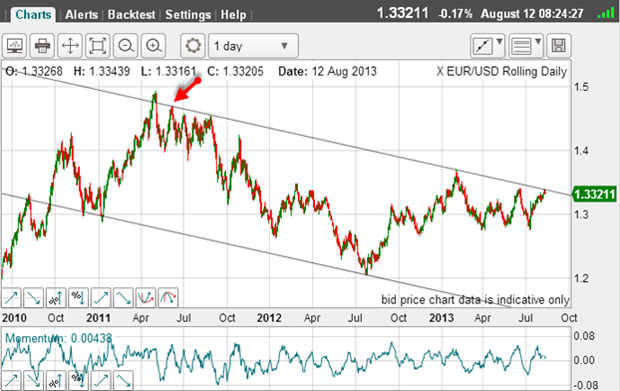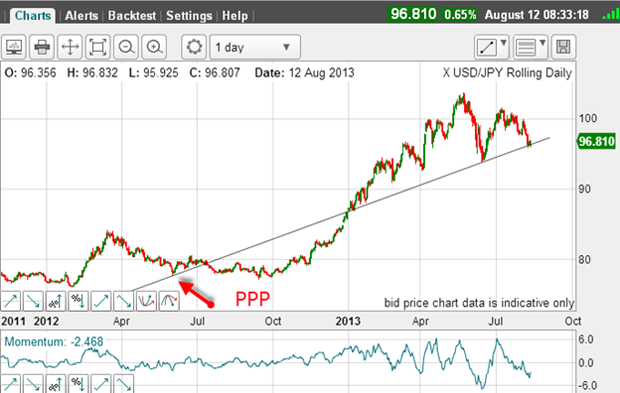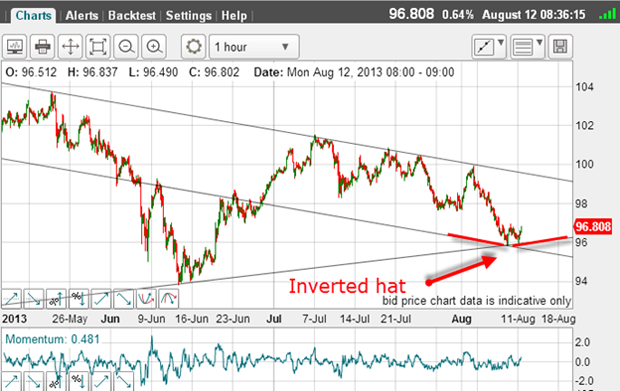The US dollar looks ready to rally in the forex market
With the dollar showing signs of an imminent rally, John C Burford explains why the currency markets are so ideally suited to his chart-trading methods.
By far the most heavily traded currency is the US dollar. And the euro is the currency most traded against it. In fact, trading against the dollar is by far the biggest market in the world.
Many traders restrict their activities strictly to forex and for good reason.
First, the markets are open virtually 24 hours a day, thereby eliminating surprise gaps in the charts which can occur when markets have re-opened after the mandated close-down in response to some news item hitting the markets during this pause.
MoneyWeek
Subscribe to MoneyWeek today and get your first six magazine issues absolutely FREE

Sign up to Money Morning
Don't miss the latest investment and personal finances news, market analysis, plus money-saving tips with our free twice-daily newsletter
Don't miss the latest investment and personal finances news, market analysis, plus money-saving tips with our free twice-daily newsletter
If the opening quote is beyond your protective stop, your loss will be greater than you had planned. This is not good.
Also, the sheer volume of trading means that market manipulation other than by central banks becomes too difficult and markets are more or less free.
That means forex markets are among the best for analysis by technical means, including my methods.
I like trading forex and I'm sure you have at least looked into these markets. Many superb trading opportunities lie within.
The value of the dollar is a critical factor behind many related markets and that is why all traders should monitor its progress.
The dollar has been in a slight uptrend in recent months, but is currently testing a long-term downtrend line. Breaking below this line would be of major significance and perhaps lead to further losses.
Of course, many eyes are upon the US Federal Reserve, which has hinted that it may begin tapering' its massive dollar-creation programme as early as next month.
The impact on the dollar would be great, of course, whichever decision is made.
But this has set up some interesting situations on the charts of some currencies let's look at two of them.
EUR/USD is at a critical point

Note that I did not use the previous higher high. That is because with the second high, I can capture many more touch points with my line.
Also, I have a lower tramline which captures several touch points and sports a prior pivot point (PPP). Despite the slight overshoots, this is a reliable tramline. It validates my upper one.
The point to note is that since June 2011, the market has been trading in the channel between the tramlines. There has been no trading outside of this channel, which has been going now for over two years a very long time in the markets! The lines represent solid lines of support (lower) and resistance (upper).
And currently, the market is testing the upper line again. Remember, the upper line is a line of resistance.
If the market punches above this line, it would be breaking over two years of reliability.
So the market is at a critical point.
What can the hourly chart tell us?

I have my tramline trio with the upper line taking in the three major highs and having a nice PPP (in May).
My centre tramline has only one touch point, but a good PPP, and my lowest tramline passes close to the major low on 9 July.
These are really reliable tramlines.
But note that the upper tramline crosses the major down-sloping tramline I have on the daily chart.
Where they cross, I call that a hat' and it represents heavy resistance. First, from the resistance of the down-sloping tramline (daily chart), and then from the upper tramline on the hourly.
When the market rallied into the hat, it was reversed by the powerful resistance inside the hat.
That then is a great place to look for a short trade, expecting the resistance to hold. These are some of the best trading opportunities I know.
The big test comes if the market declines to the centre tramline. If it breaks below that, it would help confirm the bearish case. And if it went on to break below the lowest tramline, that would be even better.
But the hat resistance may not hold that is always possible. The market may decide to overcome that resistance. And that would change the bearish scenario entirely. That is why stop-loss orders were invented, of course.
But so far, the odds favour a turn at the hat. Now, onto the yen.
A great trade in USD/JPY

Here is the daily chart showing a solid trendline which has a very nice PPP (red arrow)
Remember, I always look for a PPP when deciding where to start looking for a reliable trendline (or tramline).
The market is currently testing this line.
Now here is the hourly:

I have a superb upper tramline taking all of the major highs, and my lower tramline has solid PPPs, but only one touch point at last week's low.
But observe the crossing of the lower hourly tramline with the long-term trendline it has formed an inverted hat.
Just as in the euro case, this is a strong barrier to further progress, but this time, it represents major support and so an excellent place to look for a long trade with a protective stop just below the hat for a low-risk trade.
What more can you ask of a trading system?
I know which way to trade (long or short), I have a logical entry area, and I have a logical place to enter a protective stop in case I am wrong.
I also have a major price target the upper tramline if the market goes my way.
It is a complete system in a nutshell I am keeping it simple, which to my mind, is the key to trading success.
Get the latest financial news, insights and expert analysis from our award-winning MoneyWeek team, to help you understand what really matters when it comes to your finances.
John is is a British-born lapsed PhD physicist, who previously worked for Nasa on the Mars exploration team. He is a former commodity trading advisor with the US Commodities Futures Trading Commission, and worked in a boutique futures house in California in the 1980s.
He was a partner in one of the first futures newsletter advisory services, based in Washington DC, specialising in pork bellies and currencies. John is primarily a chart-reading trader, having cut his trading teeth in the days before PCs.
As well as his work in the financial world, he has launched, run and sold several 'real' businesses producing 'real' products.
-
 Autumn Budget tax changes: how is your generation affected?
Autumn Budget tax changes: how is your generation affected?The chancellor expects everyone to do their bit to boost the nation's finances but the tax burden is by no means shared equally
-
 Revealed: pension savers ditch investment trusts and favour passive funds
Revealed: pension savers ditch investment trusts and favour passive fundsDemand for investment trusts is cooling among self-invested personal pension (Sipp) customers, who are increasingly choosing money market funds, passive funds and individual shares